Phyrexia: All Will Be One Mechanics | New & Returning
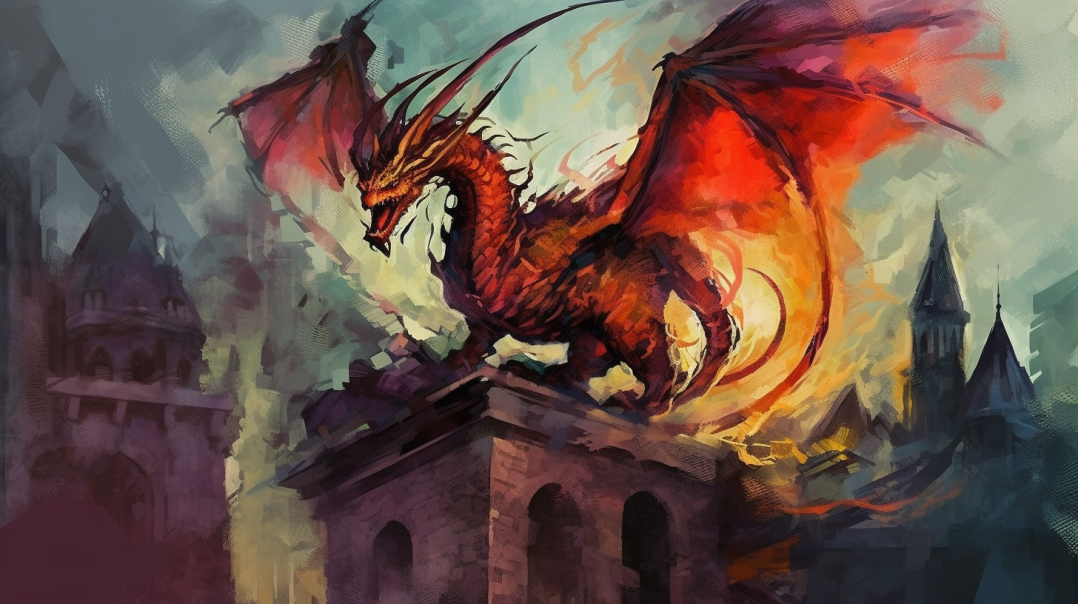
The past year has been a fascinating one for Magic mechanics. Both Kamigawa: Neon Dynasty and Dominaria United embraced returning mechanics such as Sagas, Channel, Ninjutsu, Domain, and Kicker, while allocating less room to new ones. This trend appears to be continuing in the newest set – Phyrexia: All Will Be One – as it features more of the old than any Premier set since Time Spiral Block. Today let’s take a look at these mechanics: what they suggest about ONE Limited, and how they reflect on current design thinking from Wizards of the Coast.
Oil
Oil counters is a fitting theme for the oil-soaked Phyrexia. Mechanically, it allows the Phyrexians to accumulate oil as a valuable resource to gain power over others.
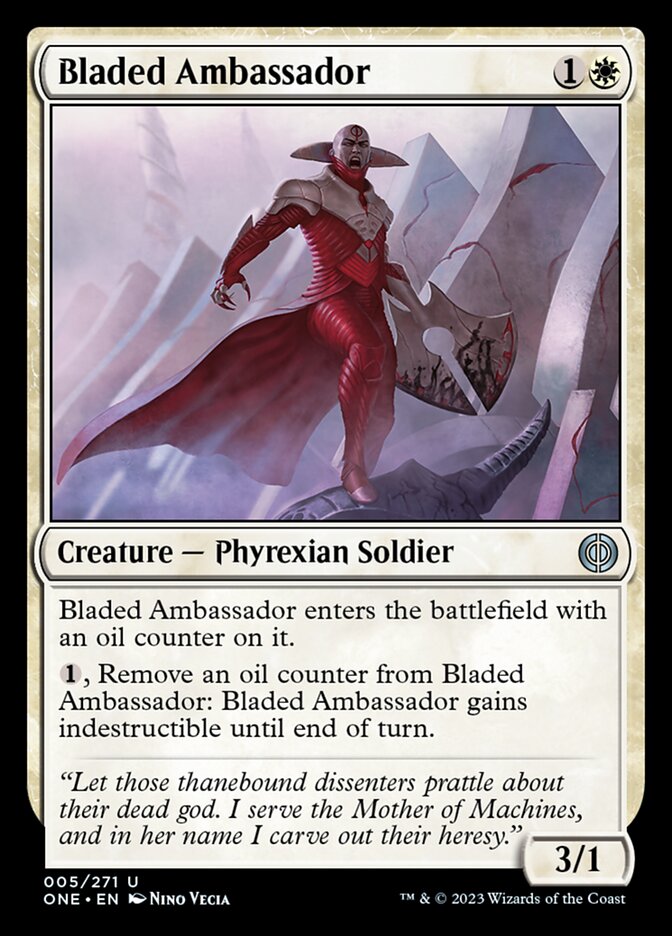
In the past, Magic had strict rules against having more than one type of counter commonly placed on creatures, mostly due to the difficulty of keeping track of different types of counters or states. Punch-out counters were introduced in sets like Amonkhet, Ikora: Lair of Behemoths, and Brothers’ War to resolve this issue. Oil counters are used extensively in this set, replacing the traditional +1/+1 counters.
Typically, having a counter used in various ways such as charge counters, +1/+1 counters, or time counters for Vanishing, would raise concerns. However, with oil counters taking center stage and no competing counters, keeping track of this versatile resource should not be too difficult.
Corrupted
Corrupted is the newest of the ONE’s ability words, granting an upgrade to cards when an opponent accumulates three or more poison counters. We’ve seen similar Threshold mechanics before, such as on Chained Throatseeker and Corrupted Resolve; yet those required any amount of poison rather than 3.
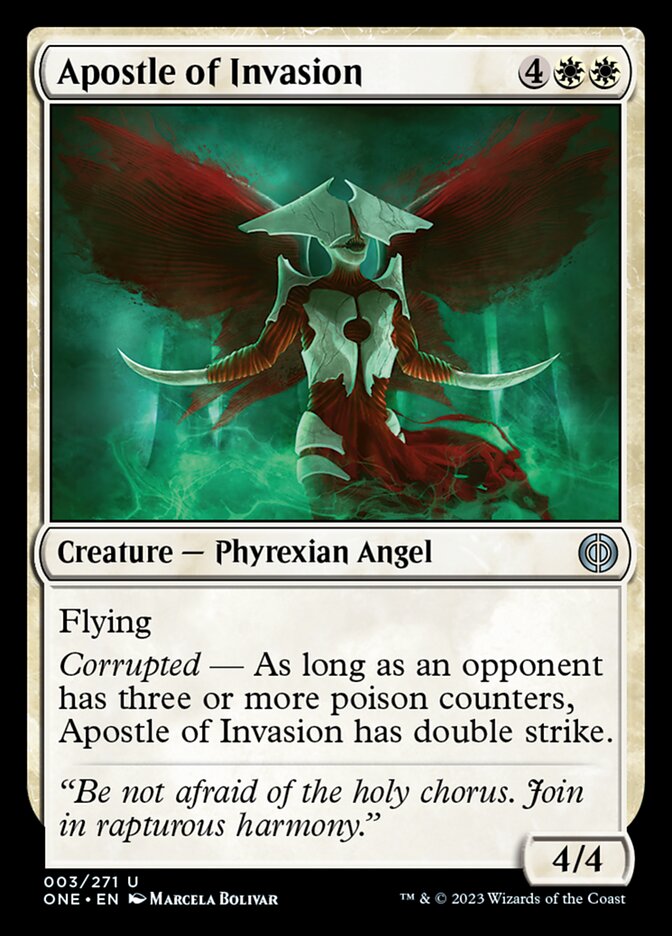
This mechanic looks set to create interesting and dynamic gameplay between both decks focused solely on poisoning opponents to 10 counters, and those that prefer a hybrid approach of damage with some poison on the side. Much like Toxic, it makes for a far less one-dimensional game than what was seen in Scars of Mirrodin – where every block was essential if there were any poison at all.
The number 3 has been carefully chosen here, too. Had any amount of poison been enough for an upgrade (as with SOL), then much of the tension would have been lost; once there is that first point of poison no real milestone need be reached until 10 counters are acquired. Whereas with 3, as long as you can afford to take a hit or two you can still survive long enough to get back into the game. Furthermore, your opponent may be able to Proliferate up to 3 quick enough – but at least this will be a risk you’ve consciously chosen to take.
Toxic
Next up is Toxic. It’s a notable upgrade from its predecessors: Poisonous from Future Sight and poison creatures from the past. Unlike Poisonous, Toxic does not have a trigger, allowing for a more streamlined digital experience and less upkeep in tabletop.
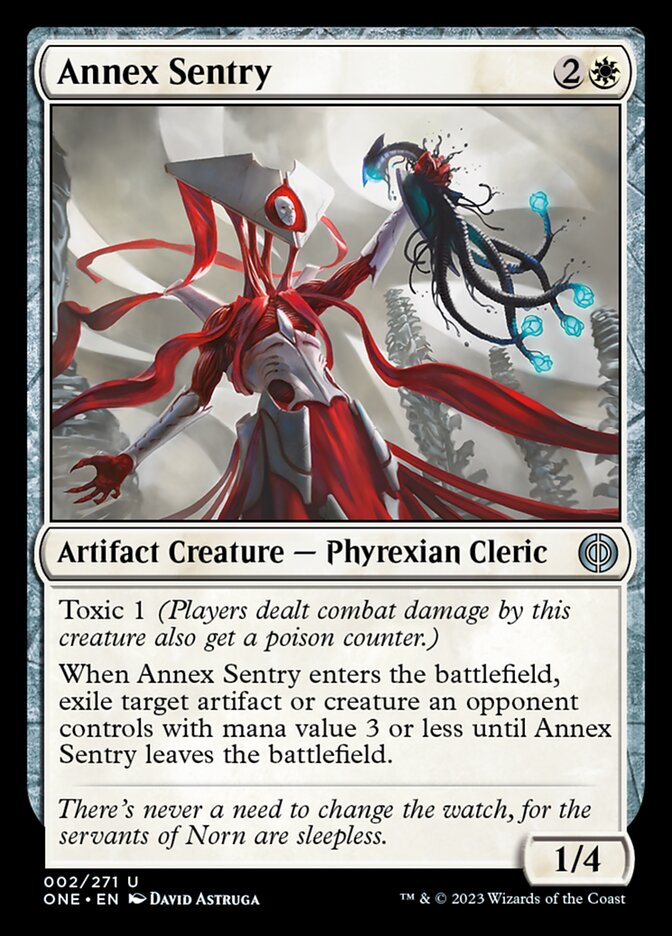
The design of Toxic is straightforward yet effective; each point of damage dealt – be it by a meek 1/1 Mite or a powerhouse Trample creature – produces an equivalent number of poison counters. It’s true that on their own these poison counters don’t accomplish much other than formulating an alternate life total; however, when used with abilities such as Corrupt and Proliferate, even the slightest hint of poisonous presence can make all the difference.
Toxic will likely be stronger in Limited than Infect was in Scars of Mirrodin – where decks had to completely switch between full-Infect creatures or none – as any combat damage you deal will count towards both reducing your opponent’s life total and adding up those precious poison counters for victory. This essentially makes for infinitely more interesting gameplays and drafts that are now far less one-dimensional.
For Mirrodin!
“For Mirrodin!” is a reimagination of the Living Weapon mechanic, which has generated various designs over the years. We have seen equipment that comes attached with a creature, such as Ancestral Blade, Giant’s Amulet, and Barbed Spike, as well as new ways to bypass the initial equip cost, such as the snap-on equipment in Zendikar Rising inspired by Grifter’s Blade.
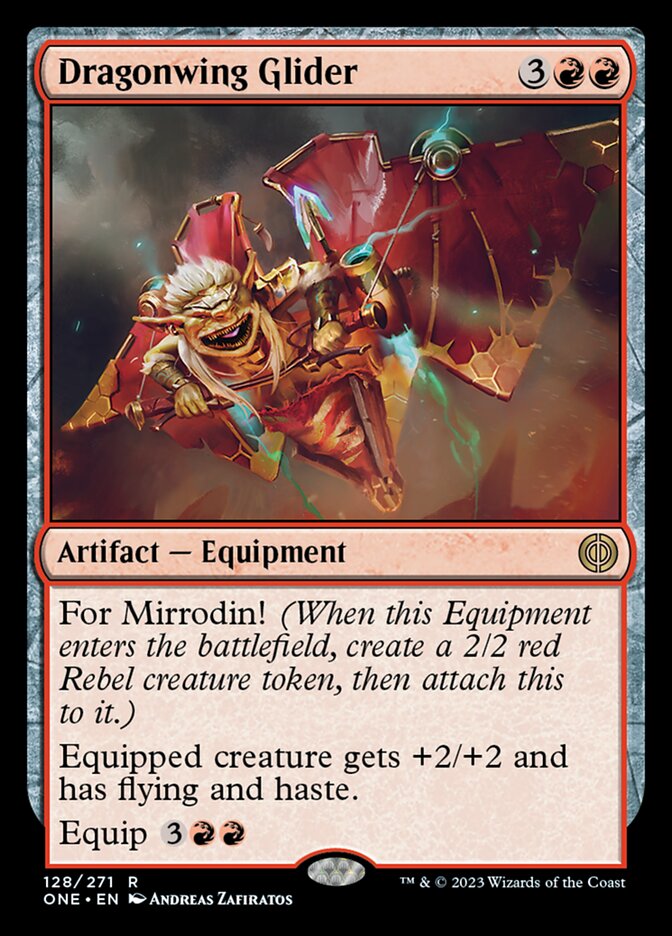
This time, instead of a 0/0 Germ, you receive a 2/2 Rebel. This shift in design significantly changes the design space. Previous Living Weapons had to offer some toughness boost so the Germ wouldn’t die right away. Now, only providing power boosts, keywords, or even an unusual ability like Blade of Shared Souls is acceptable. However, coming with a 2/2 imposes different limitations, either the bonus must be smaller than the average Living Weapon’s or the card will cost much more.
In addition to the silly name, the mechanic does not seem to bring anything particularly innovative. If it weren’t one of five mechanics, most of which are variations of familiar mechanics, and among several returning mechanics, I would be more lenient towards “For Mirrodin!”. It just doesn’t seem to have a point in a set with four other new mechanics.
Spheres
Though it’s a mini-mechanic, ONE’s Spheres are no less impactful. This new nonbasic land type pays homage to the original Phyrexia, which was itself evocative of Dante’s Inferno – each one representing one of the nine layers.
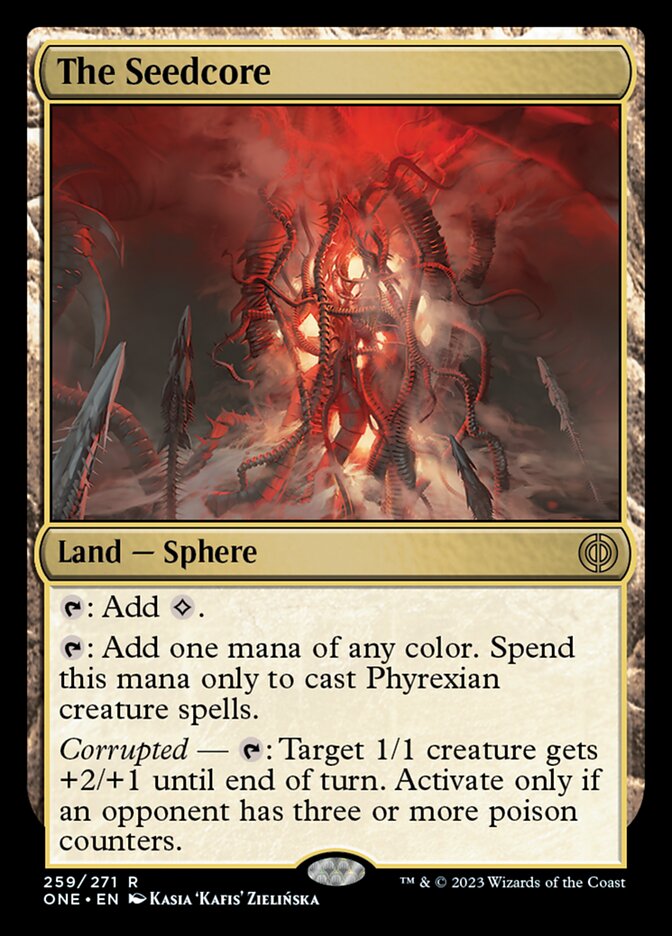
These additions to Limited and Constructed provide a subtle yet effective complexity that laces the game with texture; plus it doesn’t hurt that flavor is added to this ever-evolving world of ONE in the process.
All in all, these Spheres act as callbacks to Return to Ravnica, serving their purpose without compromising on fun or flavor. It’s what you’d expect from something as great as ONE.
Returning Mechanics
- Proliferate: A fan favorite returning mechanic in All Will Be One that requires support to function. Interacts well with Toxic and oil counters, and is one of the big Phyrexian mechanics from Scars of Mirrodin block.
- Battle Cry: A returning mechanic from Mirrodin Besieged, first introduced in 2011. It’s a go-wide, aggressive combat mechanic.
- Affinity: A returning mechanic in this set, only on Oxidda Finisher. It’s one of the most powerful mechanics in Magic, but is easier to break with artifacts than with specific card types like equipment.
- Flashback: A familiar mechanic making a comeback in ONE, with widespread popularity and exciting potential.
- Phyrexian Mana: A returning mechanic, only on activated abilities and Planeswalkers. It’s one of the most broken mechanics in Magic, but having it only on cards that require spending colored mana should make it play better.
- Compleated Planeswalkers: With Phyrexian mana comes Compleated Planeswalkers, with slightly changed functionality due to Nissa, Ascended Animist, being the first with multiple Phyrexian mana symbols.
Wrapping Up
Multiple mechanics are included in the set, including six returning mechanics, which can create a lot of mental load and make the game more complicated to play in tabletop.
The sheer amount of material present in ONE makes me apprehensive – one can only hope that this plethora of ideas end up blending harmoniously together into one cohesive experience rather than overwhelming players with too much content at once. Yet perhaps this is what Phyrexia is meant to be – a diverse collection of elements forming something greater.
Ron
Share this Post
Recent Posts
- MTG’s Olivia, Opulent Outlaw Sees Massive Price Spike Amid Assassin’s Creed Release
- Wizards Has Announced a New Charity Secret Lair for the Late Sheldon Menery
- What size are Magic: the Gathering Cards?
- Does Snoop Dogg Play Magic: the Gathering?
- Wizards of the Coast Offers Up to $145k for Creative Text Designer for MTG Cards
Product Categories
ProxyMtG@protonmail.com
